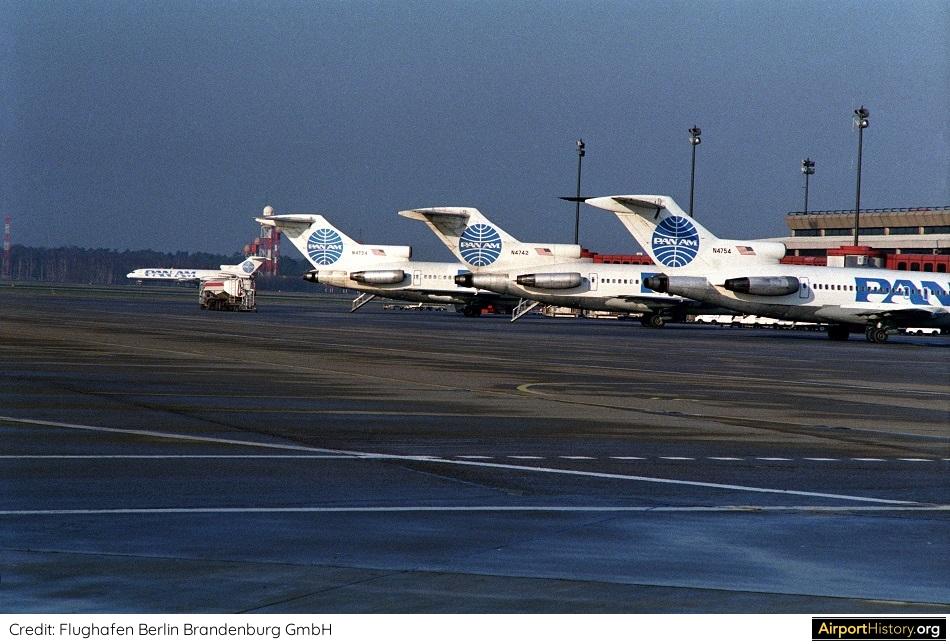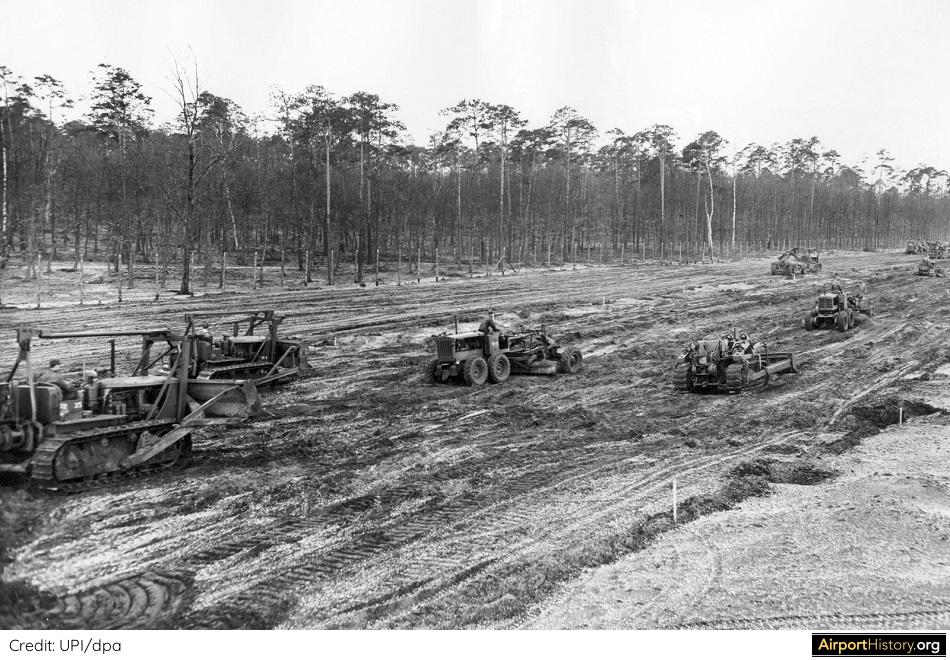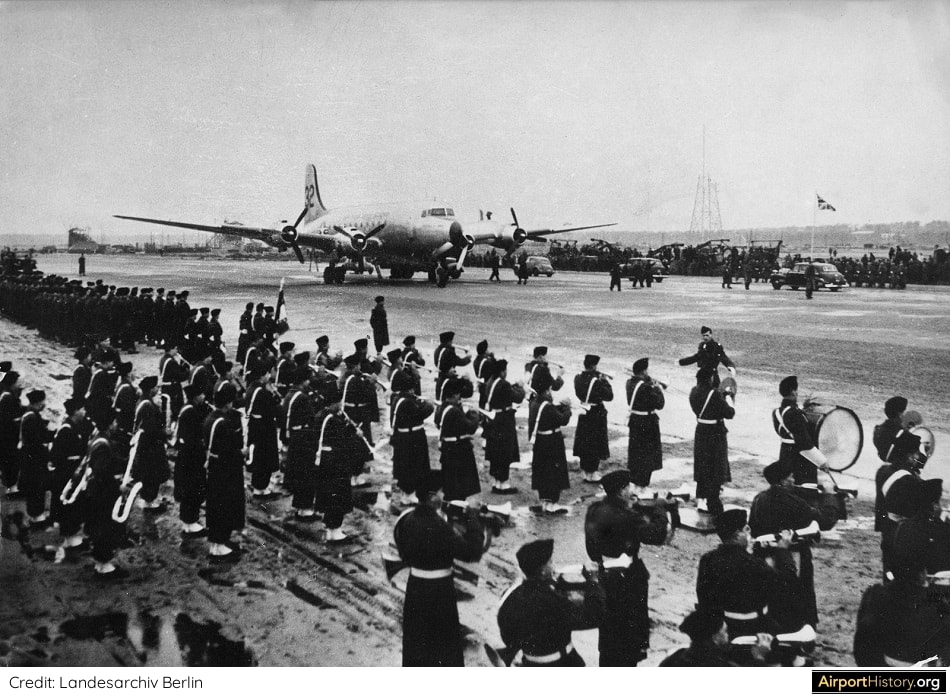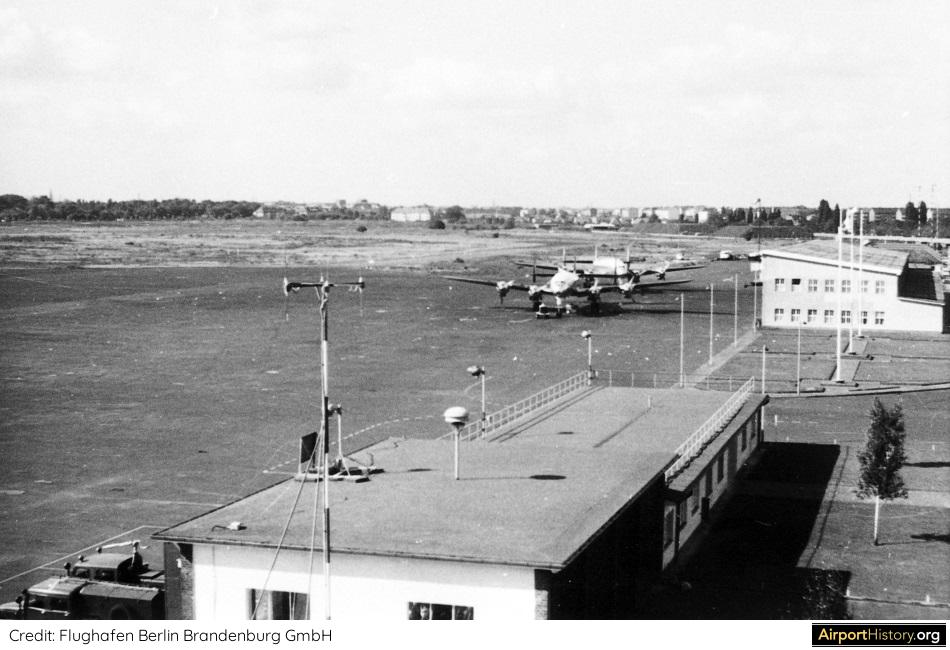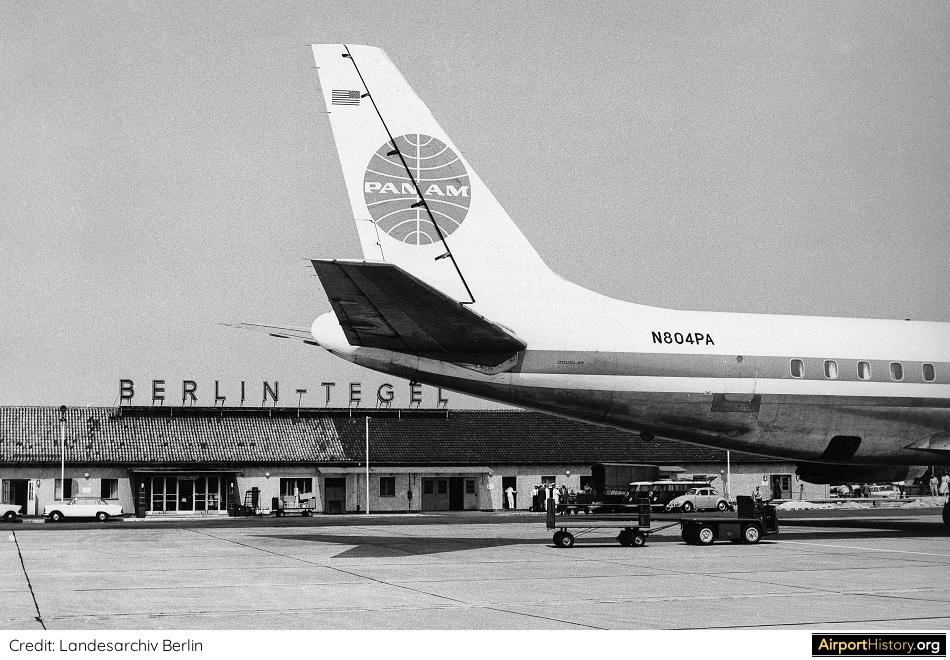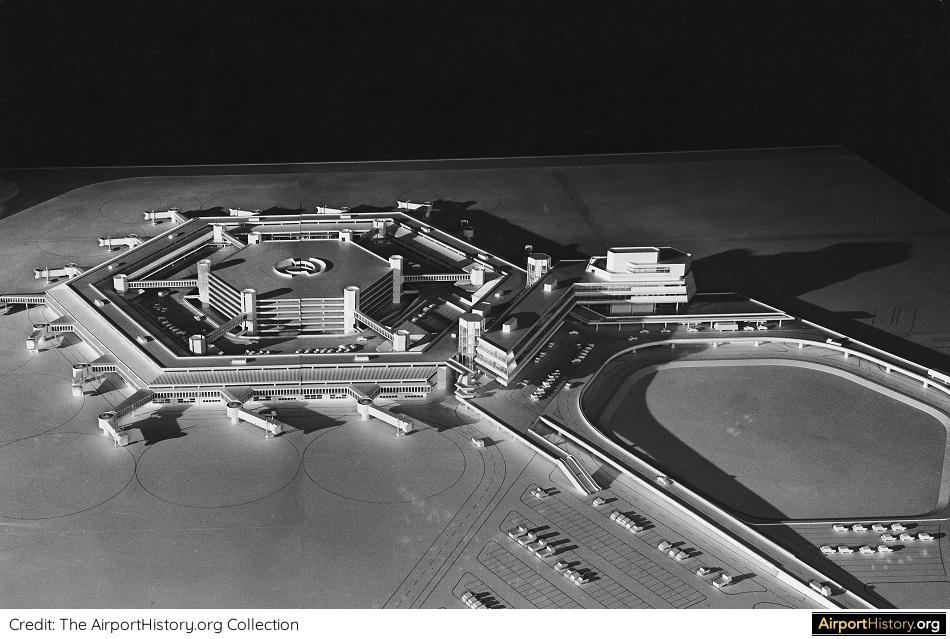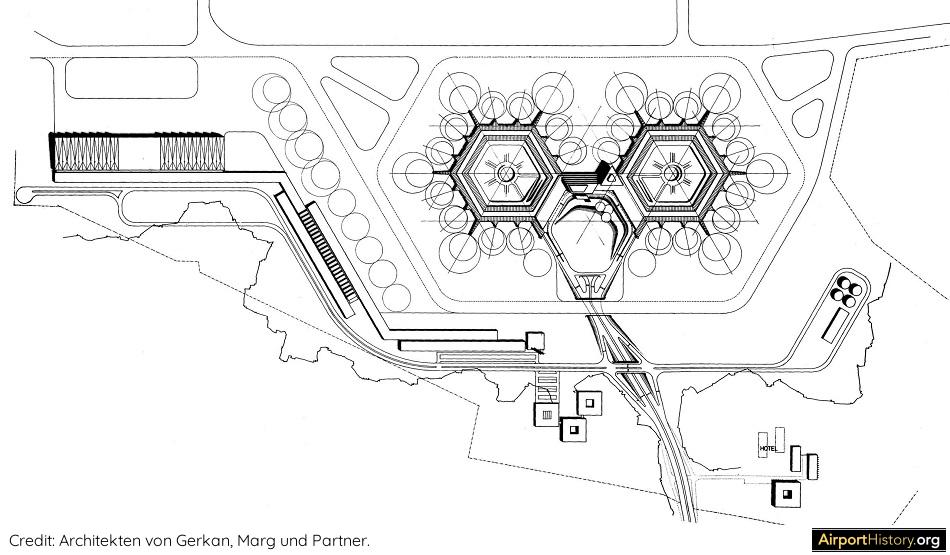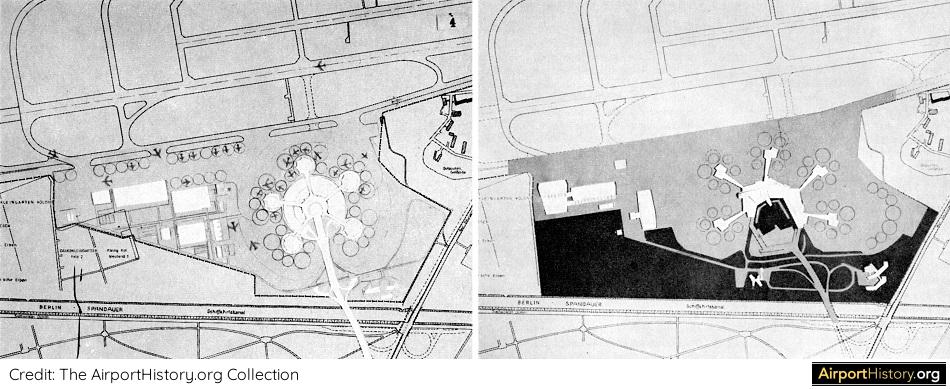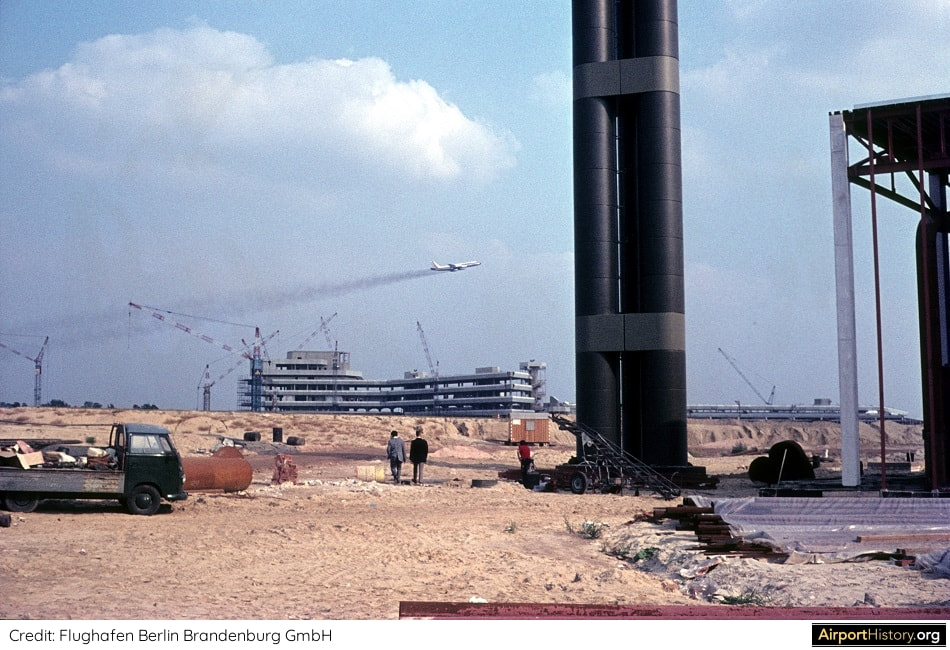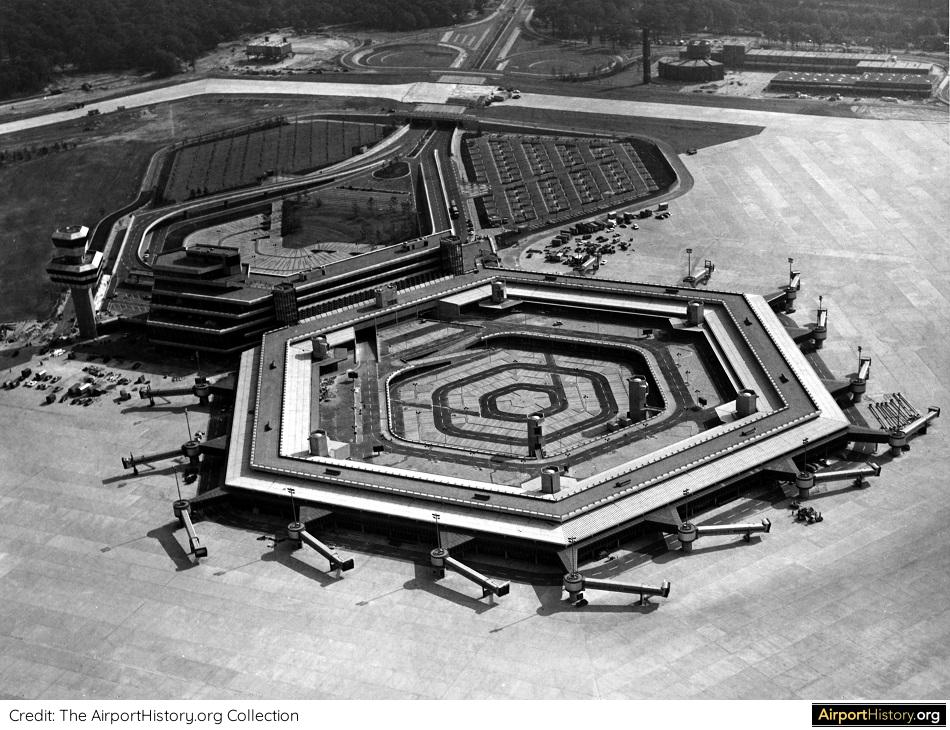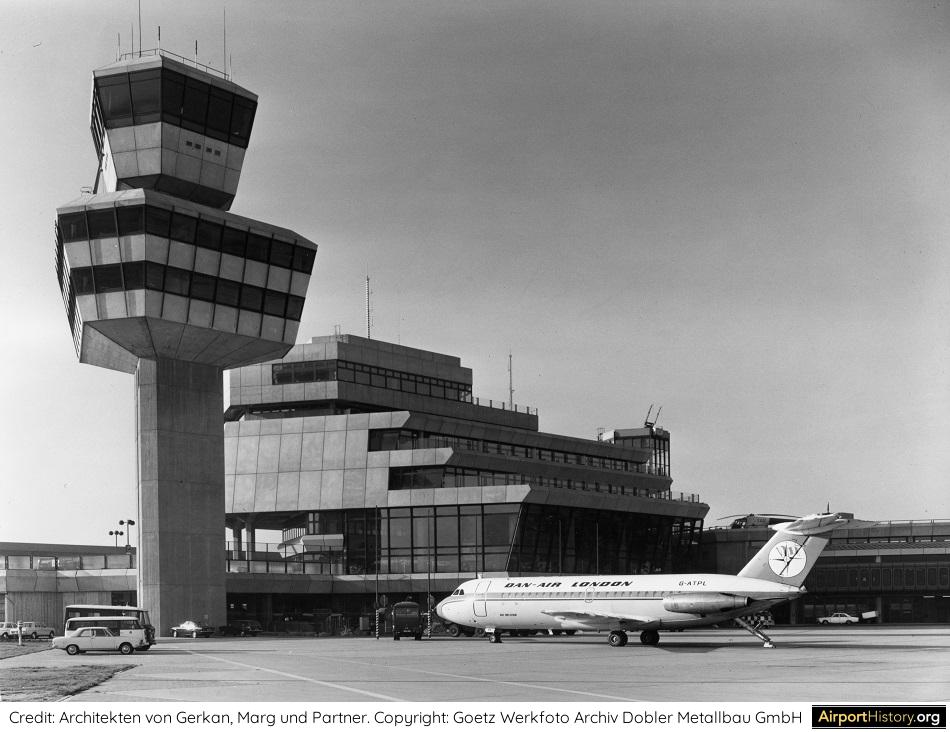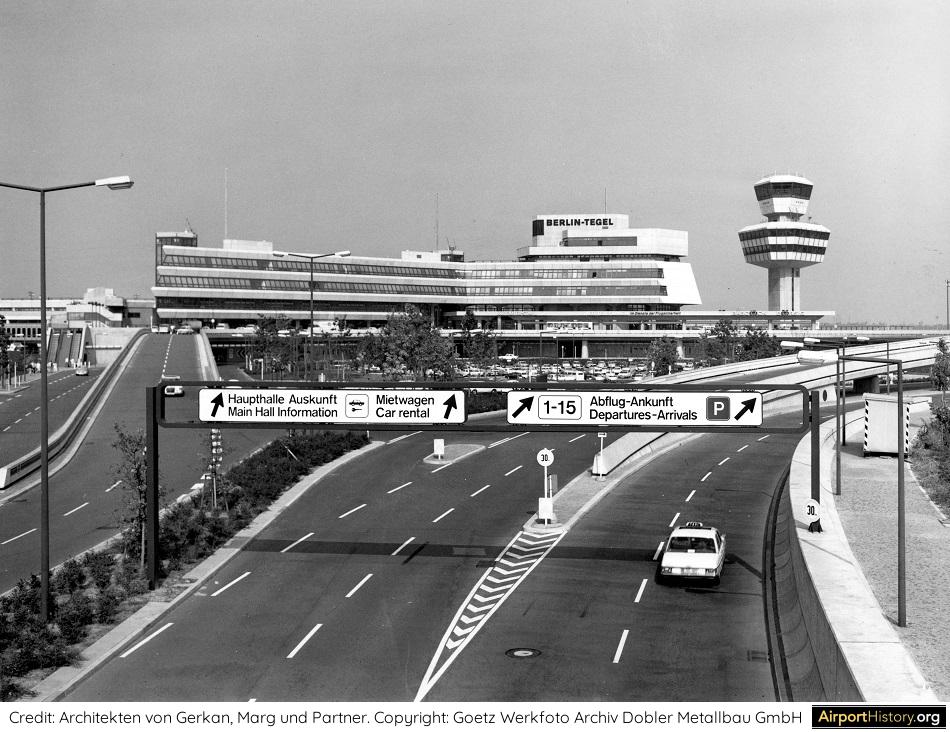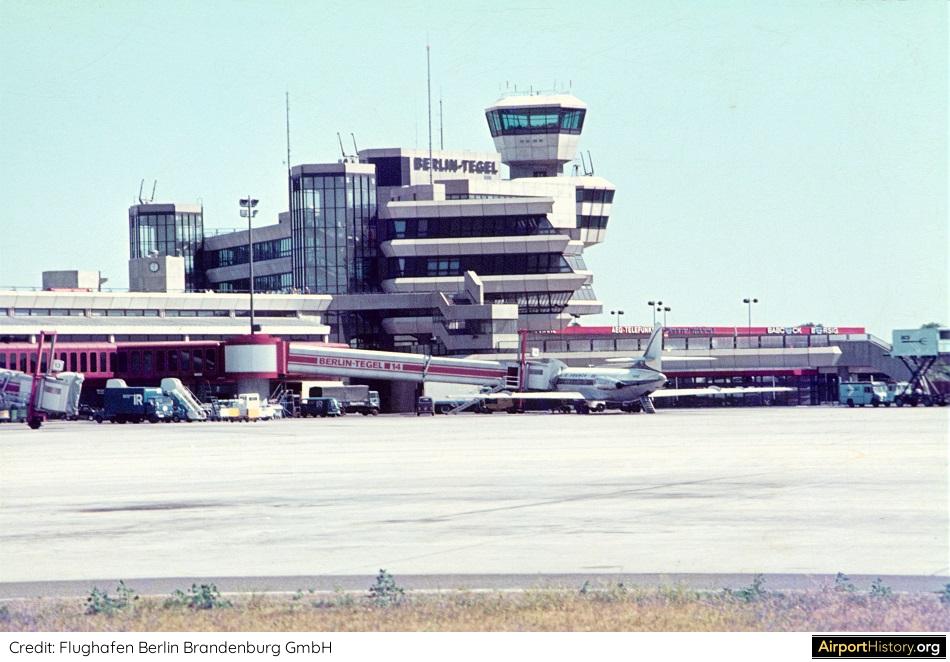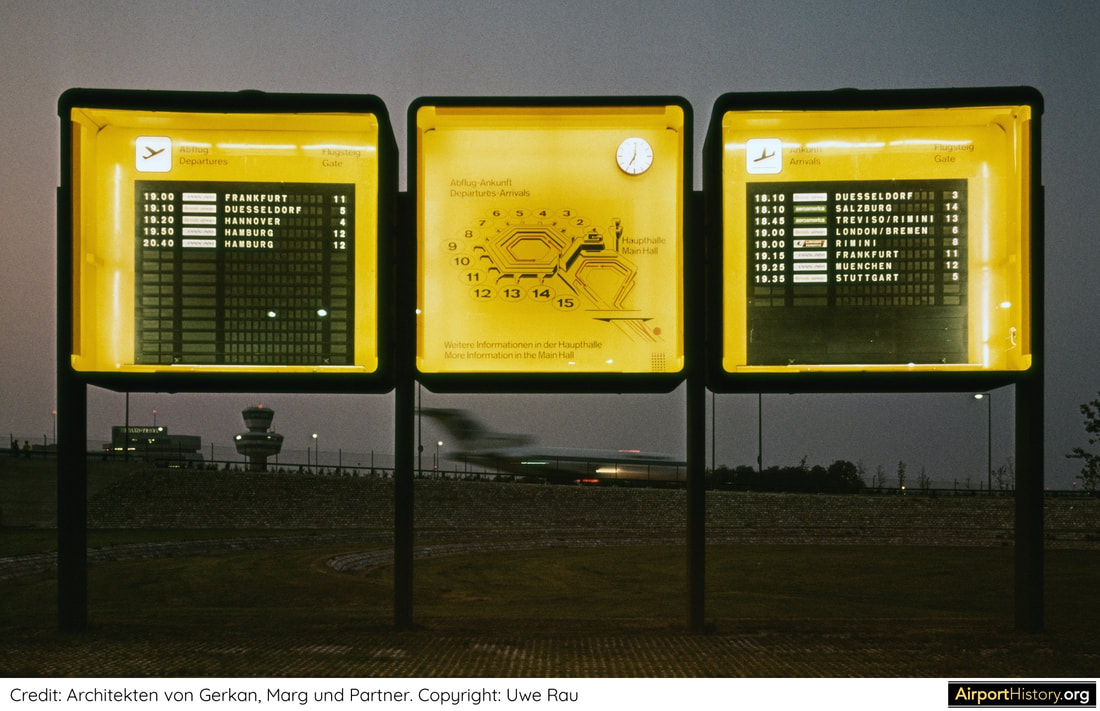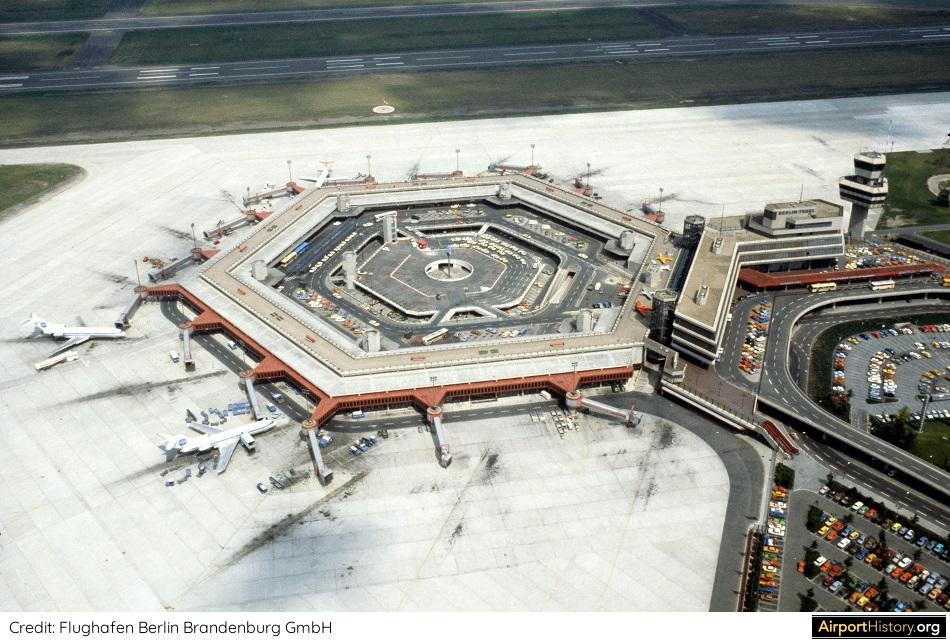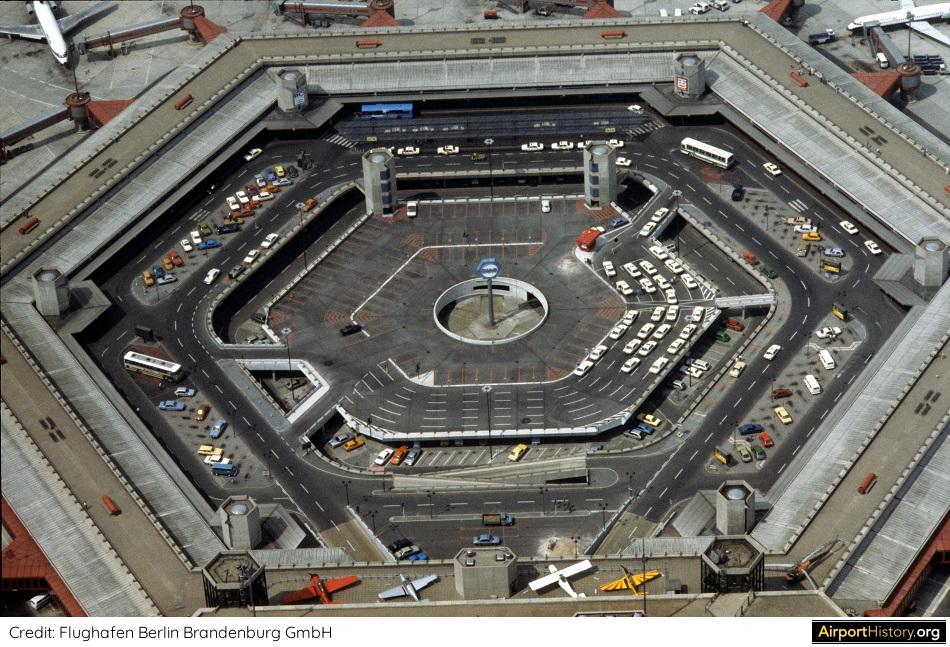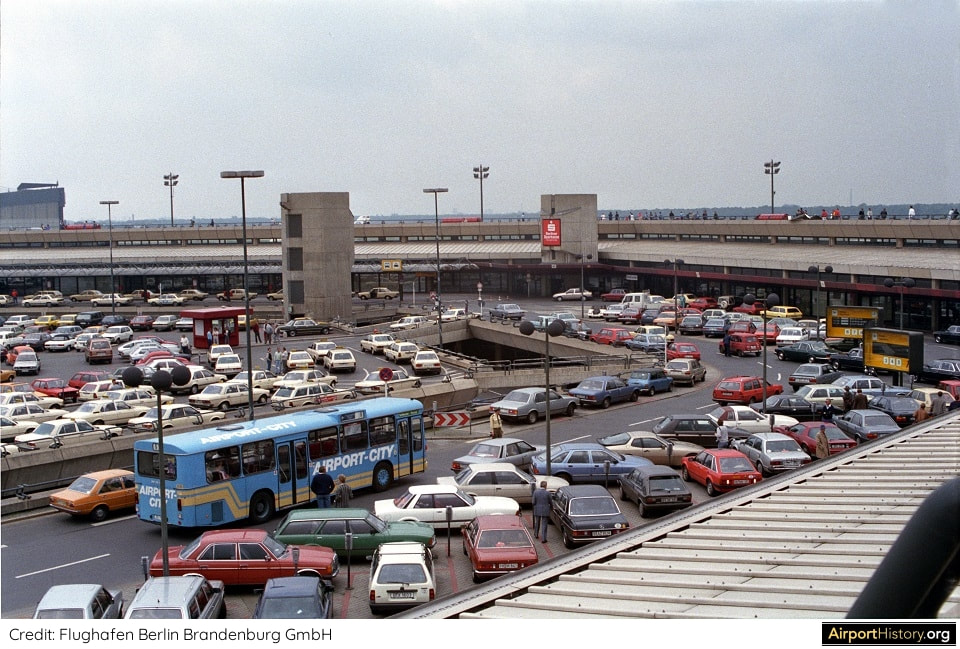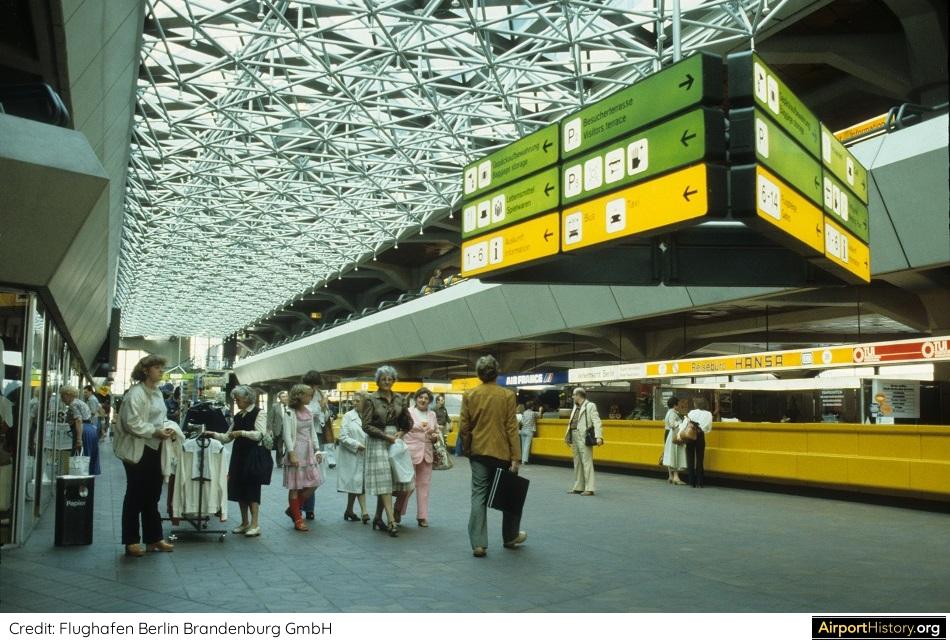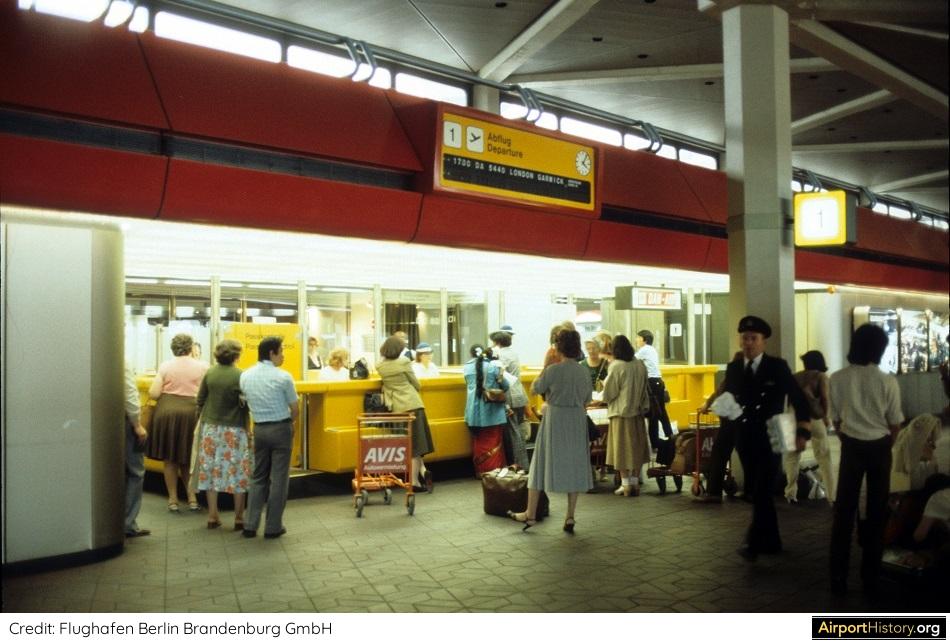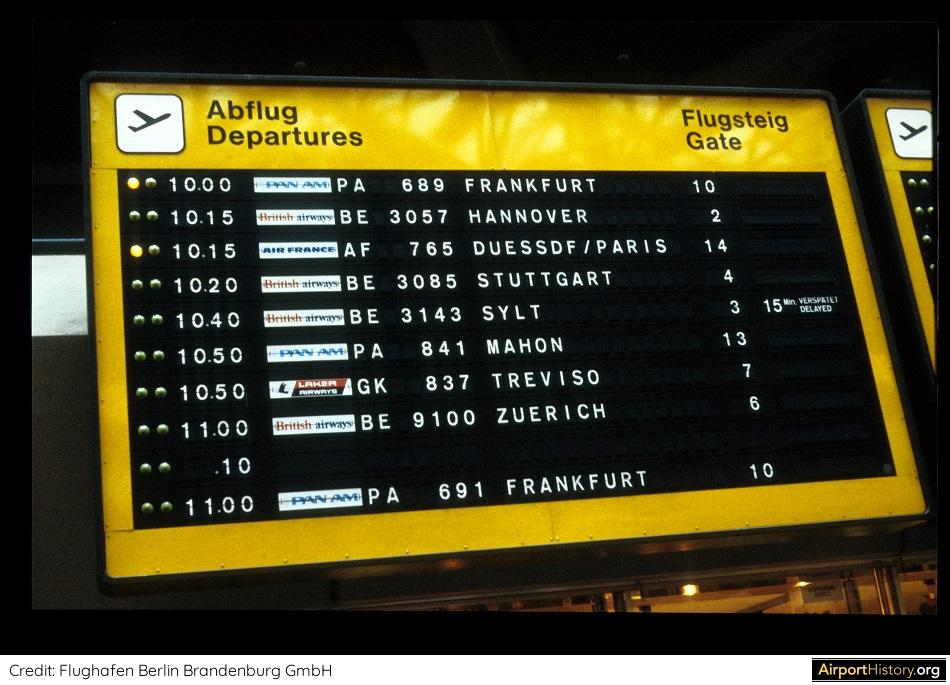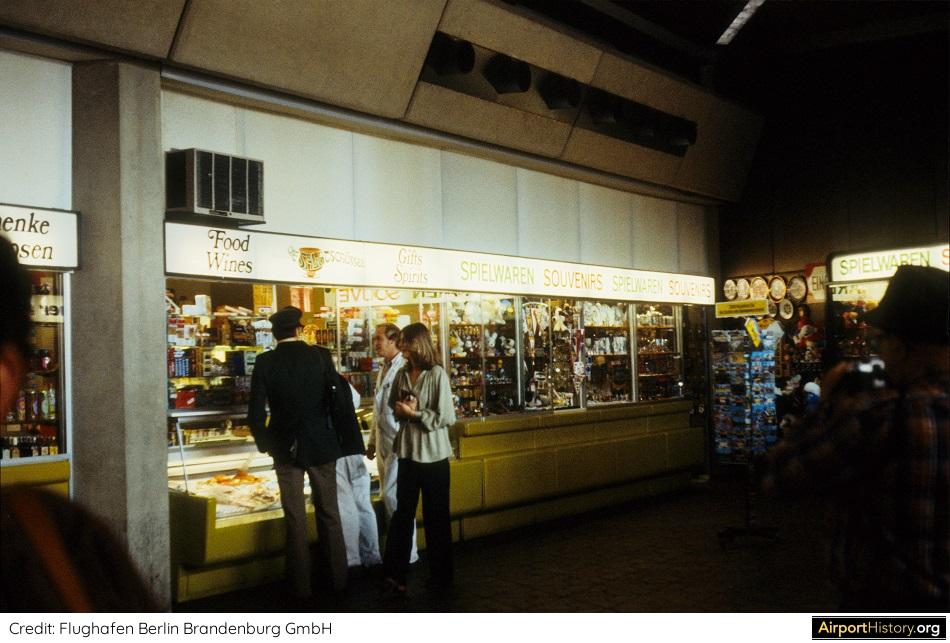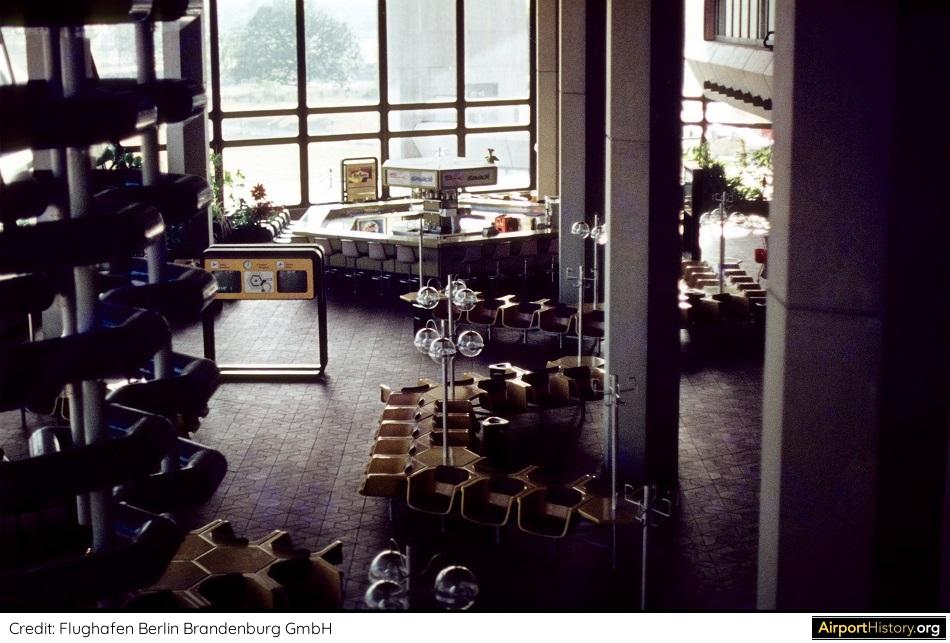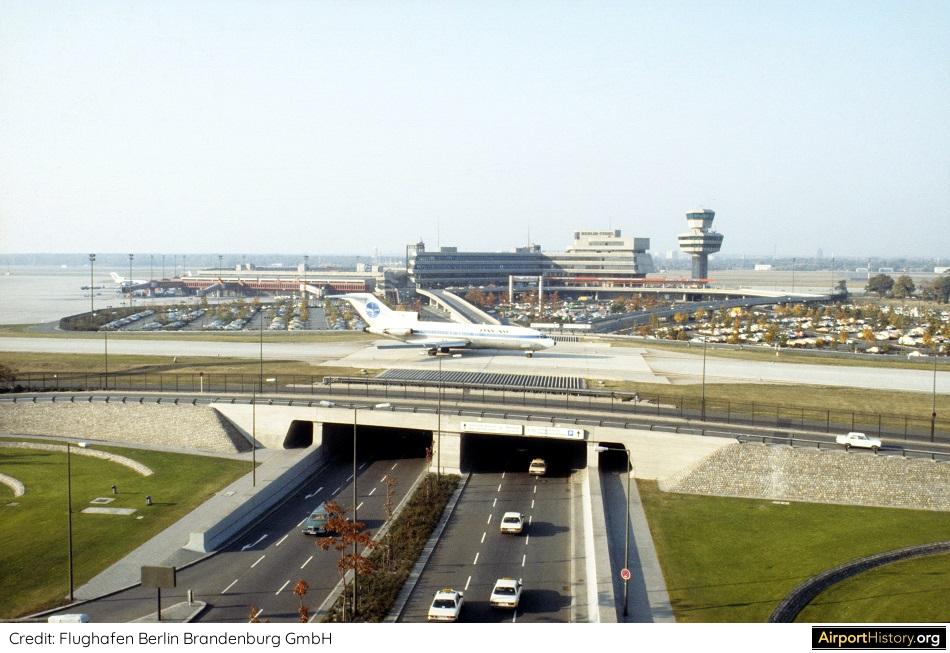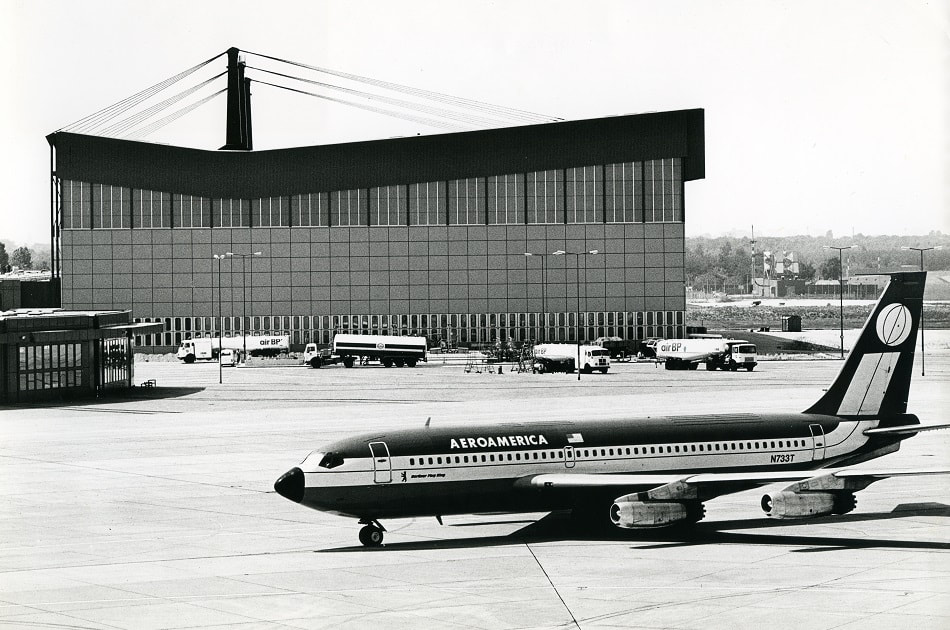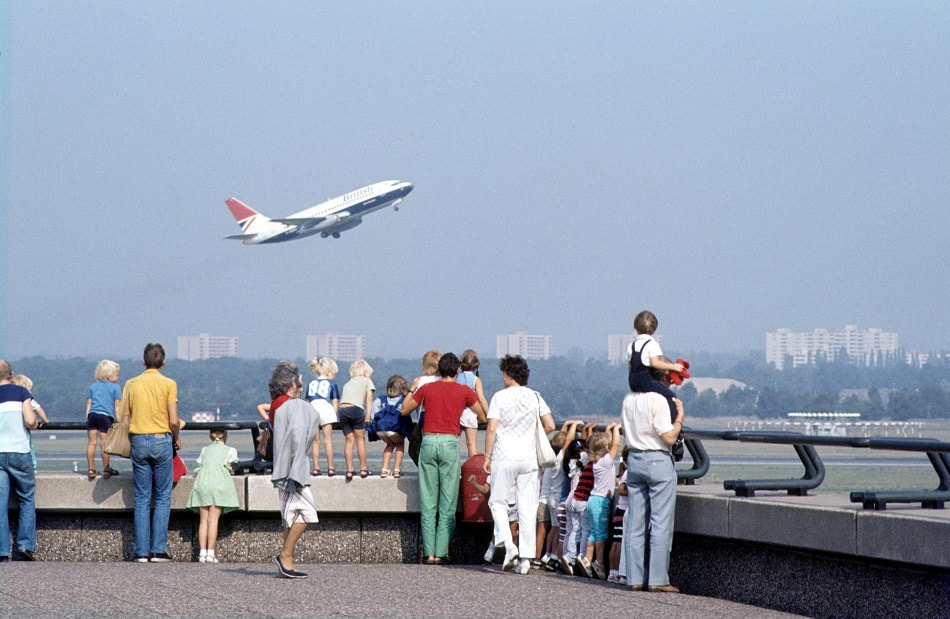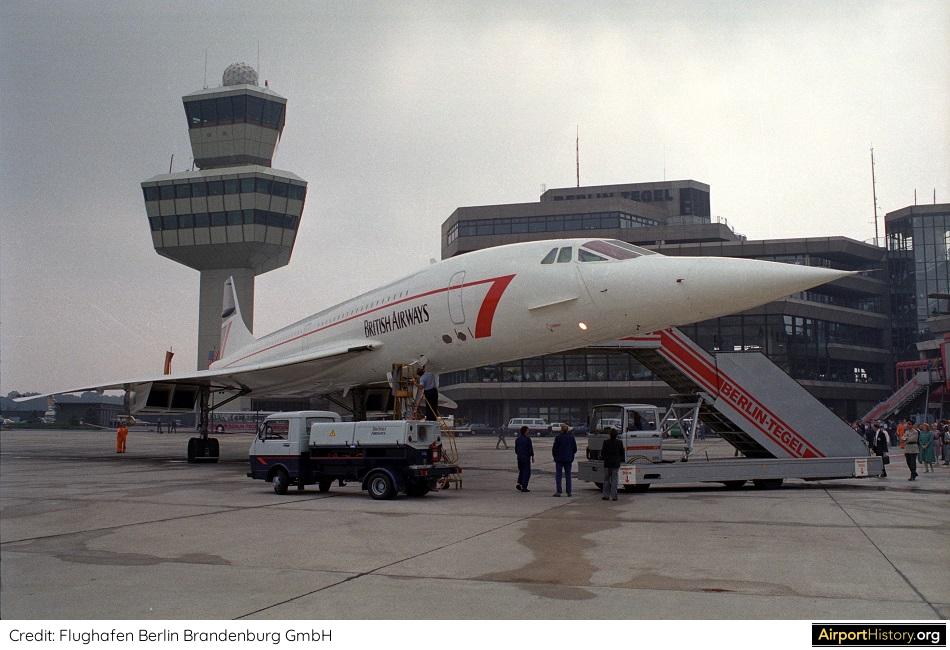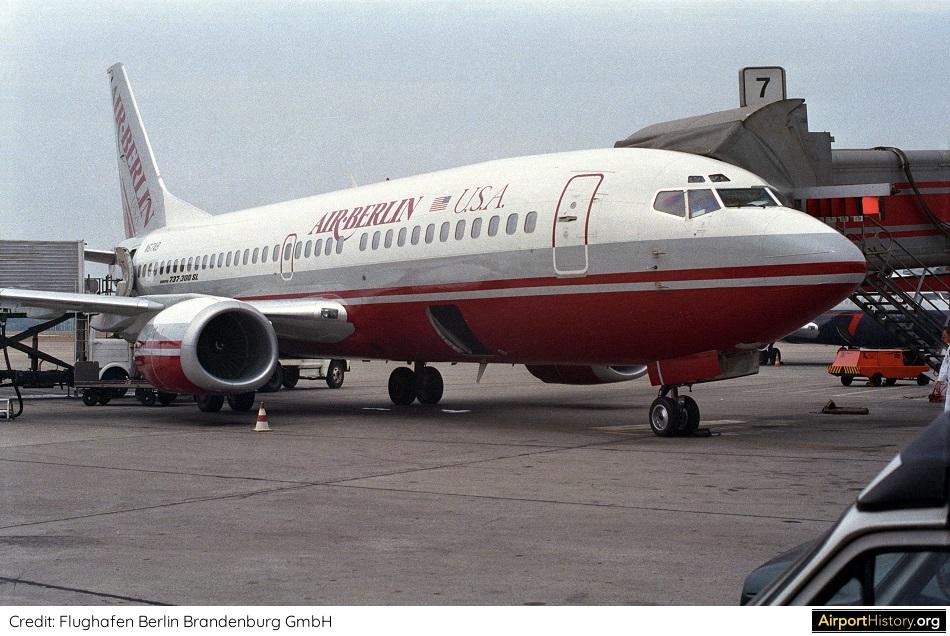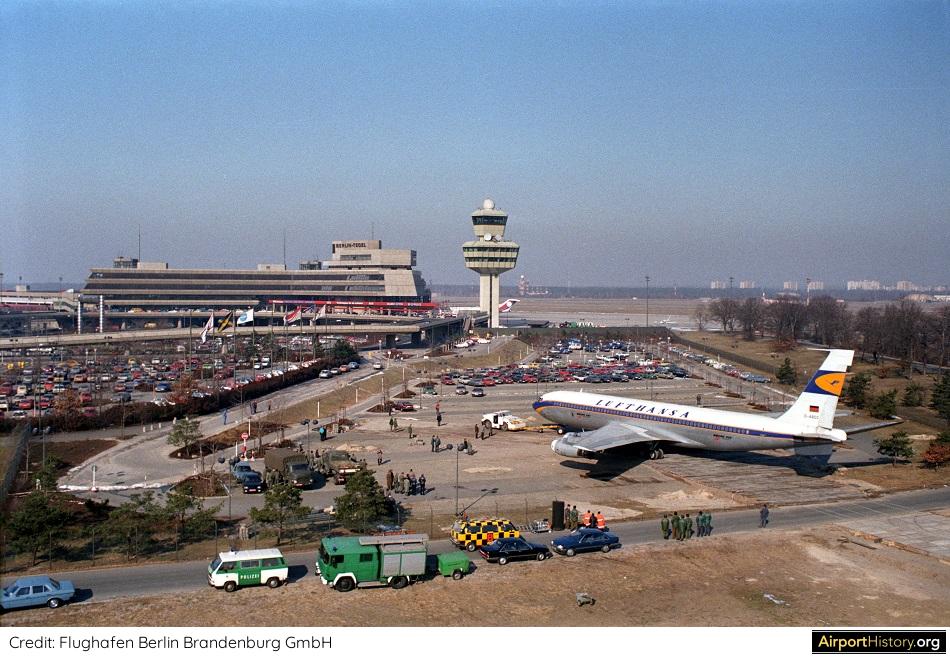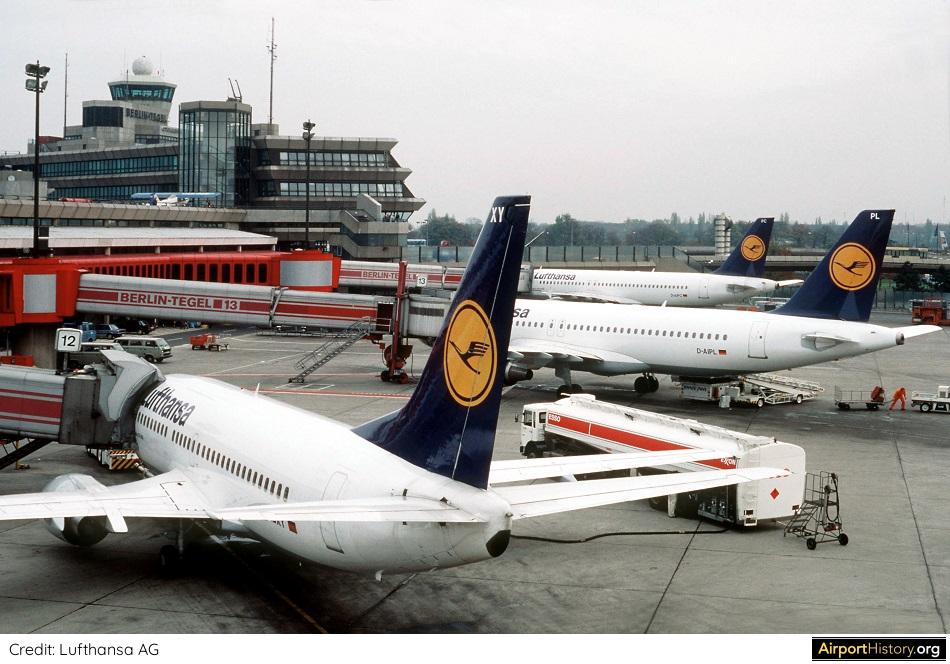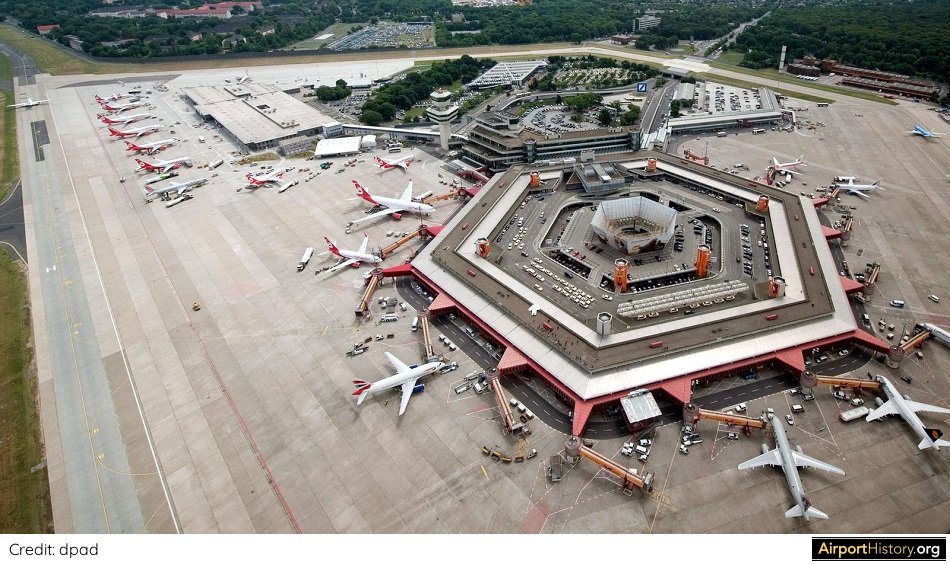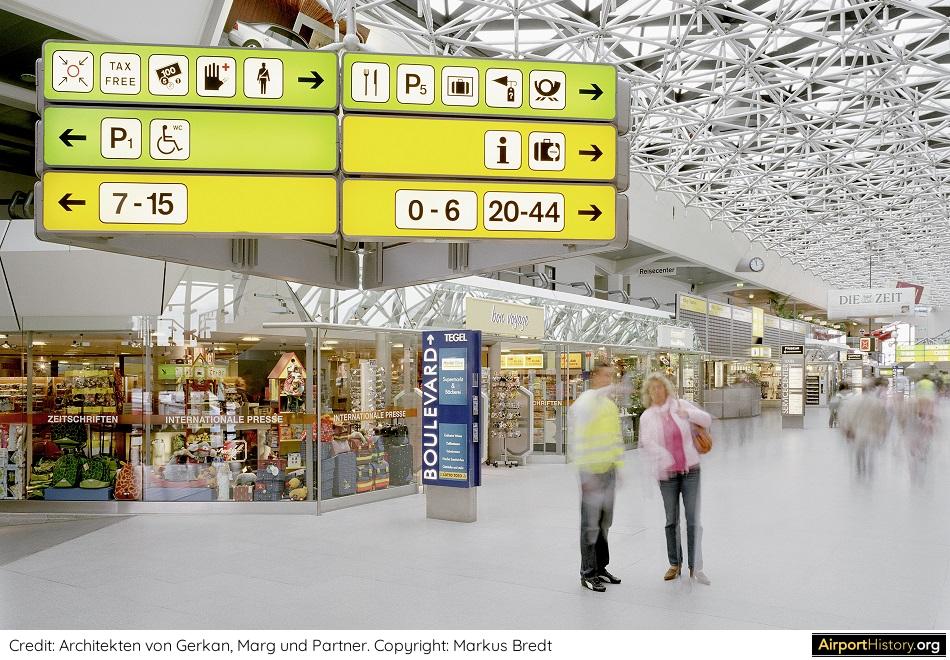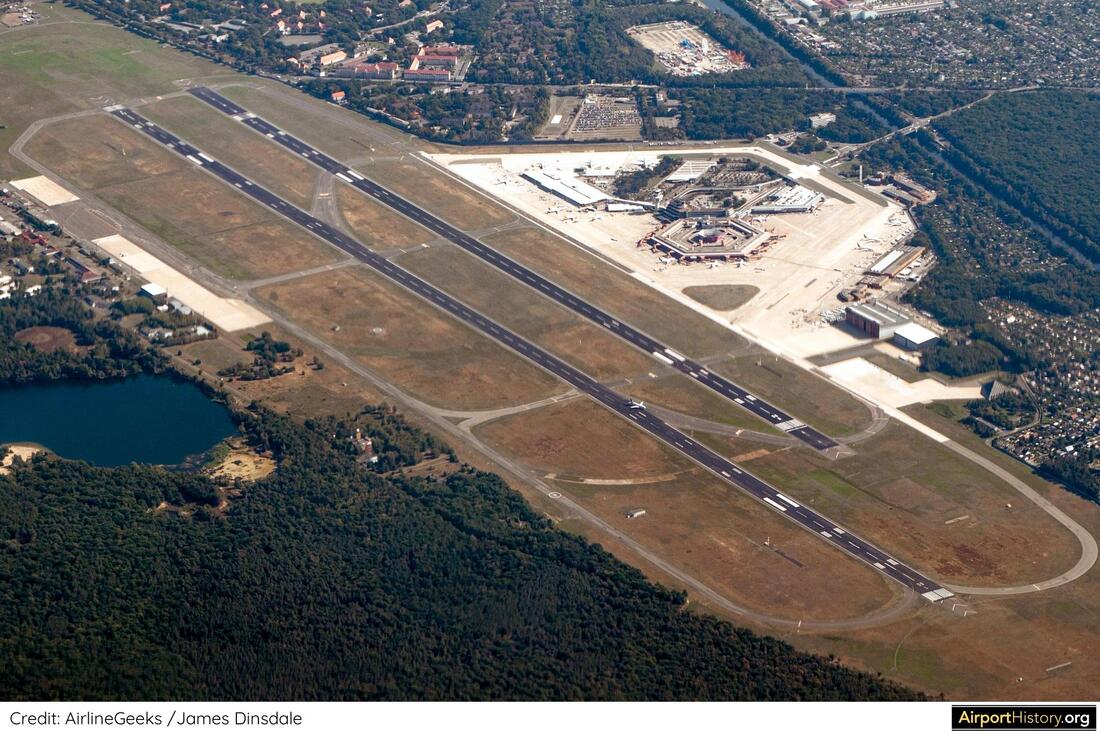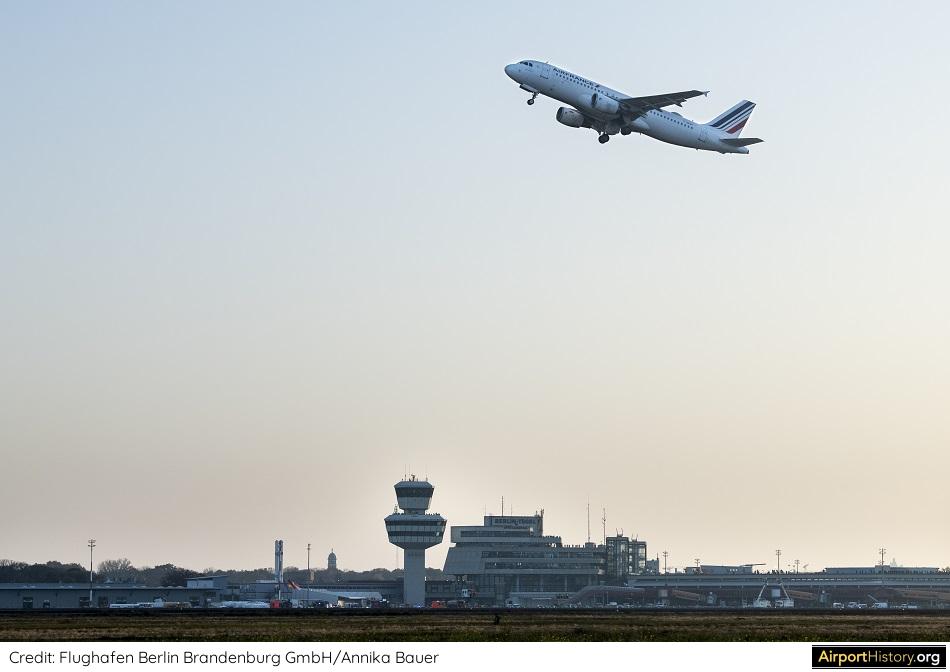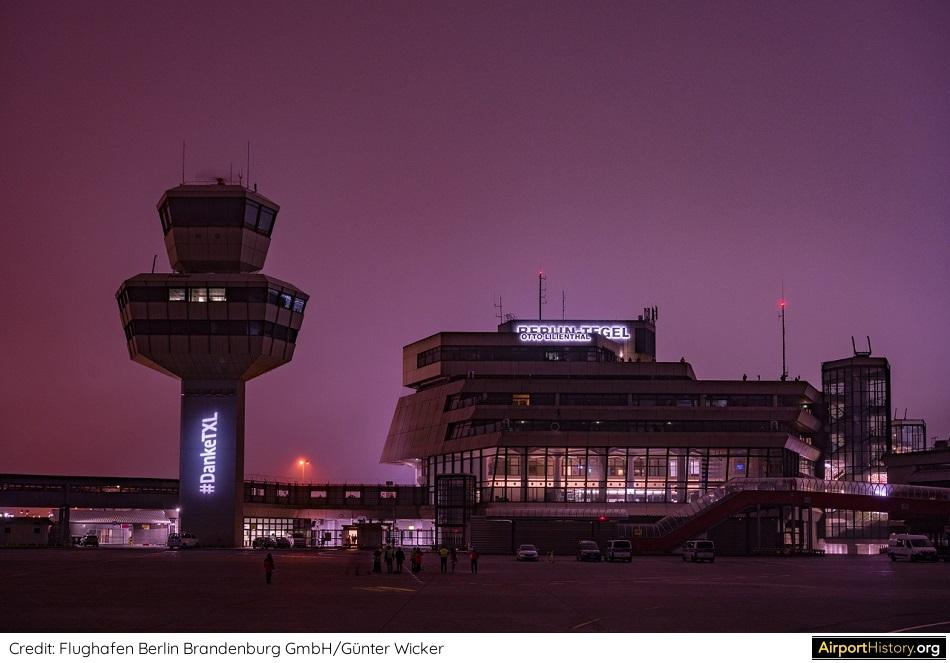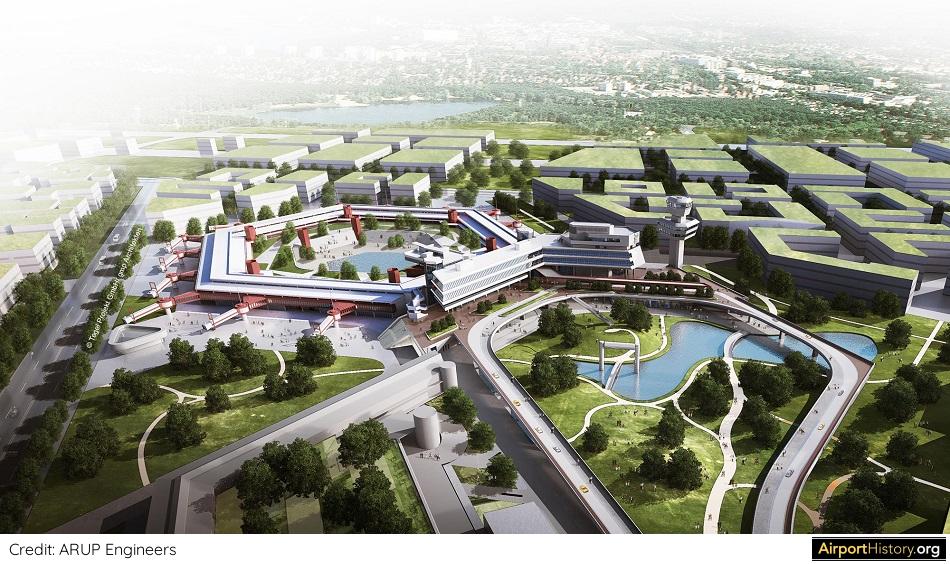Published: November 21, 2019
Recently Berlin's downtown Tegel Airport was permanently closed for traffic after 60 years of commercial service. Today, we look back at the history of this illustrious airport, with a focus on its iconic early Jet-Age terminal
I want to give a special thanks to Sezen Marie Dursun of GMP Architects, the press team of Berlin Brandenburg Airport and Shea Oakley, aviation historian, for their kind assistance in the preparation of this article.
I want to give a special thanks to Sezen Marie Dursun of GMP Architects, the press team of Berlin Brandenburg Airport and Shea Oakley, aviation historian, for their kind assistance in the preparation of this article.
The early years (1948-1965)
BEGINNINGS OF AN ICONIC AIRPORT
Between 1948 and 1989, when West Berlin was a Western-controlled enclave behind the Iron Curtain, Tegel Airport together with its illustrious neighbor Tempelhof, provided the city a critical lifeline to the West.
Between 1948 and 1989, when West Berlin was a Western-controlled enclave behind the Iron Curtain, Tegel Airport together with its illustrious neighbor Tempelhof, provided the city a critical lifeline to the West.
During the Soviet blockade of West Berlin in 1948, the French occupying power, together with US specialists and German workers, set up a new airfield in 90 days to support the Berlin Airlift. On August 5, 1948, six weeks after the start of the blockade, the construction of what was then Europe's longest runway with a length of 7,966 feet (2,428 meters) began on the site in Tegel. After the end of the Airlift, a second runway was added.
Aviation was not new to the area. Previously, the area had housed an airship hangar and later on functioned as a rocket firing range, where the illustrious Werner von Braun conducted experiments with liquid-powered rockets and missiles.
After the end of the Second World War, the Tegel site was littered with bomb craters from allied air raids and the buildings standing there were largely destroyed. Even today, duds and remains of ammunition are still buried in the ground.
Aviation was not new to the area. Previously, the area had housed an airship hangar and later on functioned as a rocket firing range, where the illustrious Werner von Braun conducted experiments with liquid-powered rockets and missiles.
After the end of the Second World War, the Tegel site was littered with bomb craters from allied air raids and the buildings standing there were largely destroyed. Even today, duds and remains of ammunition are still buried in the ground.
November 5, 1948: A music corps welcomes the first flight, a US Military Douglas C-54. The airport was officially opened at the beginning of that December.
A 1965 overview of the facilities, which were a set of simple structures, located on the north side of the airport. On January 2, 1960, Air France became the first airline to commence regular commercial operations at Tegel, using a Lockheed L-1049 Constellation. A few weeks later the airline introduced the Sud-Aviation Caravelle, the French flag carrier's new short-haul jet.
Air France shifted its entire Berlin operation from Tempelhof to Tegel as the former's runways were too short to permit the introduction of the Caravelle. The airline's Caravelle III's lacked thrust reversers that would have permitted them to land safely on Tempelhof's short runways with a full commercial payload.
Due to its occupied status, only allied airlines were allowed to fly in Berlin, with Air France being the third allied airline to fly to West Berlin as of the January 5, 1950, following American Overseas Airlines (AOA, later Pan Am) and British European Airways (BEA, later British Airways).
Air France shifted its entire Berlin operation from Tempelhof to Tegel as the former's runways were too short to permit the introduction of the Caravelle. The airline's Caravelle III's lacked thrust reversers that would have permitted them to land safely on Tempelhof's short runways with a full commercial payload.
Due to its occupied status, only allied airlines were allowed to fly in Berlin, with Air France being the third allied airline to fly to West Berlin as of the January 5, 1950, following American Overseas Airlines (AOA, later Pan Am) and British European Airways (BEA, later British Airways).
Pan Am followed Air France into Tegel in May 1964, with a year-round, thrice-weekly direct service to New York JFK. At the time, the airline had its base at nearby Tempelhof Airport, where it operated an extensive system of domestic routes, called the Internal German Service (IGS). However, Tempelhof could not handle big jets, unless they were light on fuel, passengers and cargo.
From April 1968 onwards, all charter airlines moved from Tempelhof to Tegel because Tempelhof was overloaded and could no longer handle the passenger volume. A special terminal was built for the charter airlines, which like the original airport was located north of the runway.
From April 1968 onwards, all charter airlines moved from Tempelhof to Tegel because Tempelhof was overloaded and could no longer handle the passenger volume. A special terminal was built for the charter airlines, which like the original airport was located north of the runway.
A Jet-Age terminal for Tegel
In 1965, a design competition was organized to design a new modern terminal for Tegel south of the airport. 18 prominent architects, construction officials, aviation experts and airport directors examined 68 models that had been submitted by domestic and foreign architects, both established and young.
Although terminals with linear gate concourses were already becoming the norm, the jury chose a very unconventional design prepared by Hamburg architects von Gerkan, Marg and Partners (GMP). The design featured a hexagonally-shaped terminal, which was overlooked by an adjoining control tower and administration building.
The outside of the terminal boasted 14 aircraft stands served by boarding bridges. The inside of the two-level structure contained circulation roads, drop-off and pick-up curbs, and short-term parking. This design allowed vehicles to drop off passengers a mere 98 feet (30 meters) from the gate. This arguably makes Tegel the first large-scale, "drive-in" airport design, predating that of airports such as Dallas-Ft. Worth and Kansas City, even though these airports would technically open earlier than Tegel.
The terminal had a processing capacity of 2,500 passengers per hour, which--depending on how flights were distributed over the day--translated to an annual capacity of 5 to 7.5 million passengers per year.
Although terminals with linear gate concourses were already becoming the norm, the jury chose a very unconventional design prepared by Hamburg architects von Gerkan, Marg and Partners (GMP). The design featured a hexagonally-shaped terminal, which was overlooked by an adjoining control tower and administration building.
The outside of the terminal boasted 14 aircraft stands served by boarding bridges. The inside of the two-level structure contained circulation roads, drop-off and pick-up curbs, and short-term parking. This design allowed vehicles to drop off passengers a mere 98 feet (30 meters) from the gate. This arguably makes Tegel the first large-scale, "drive-in" airport design, predating that of airports such as Dallas-Ft. Worth and Kansas City, even though these airports would technically open earlier than Tegel.
The terminal had a processing capacity of 2,500 passengers per hour, which--depending on how flights were distributed over the day--translated to an annual capacity of 5 to 7.5 million passengers per year.
A 1965 model of the future Tegel Airport. The original design featured a multi-level parking structure in the middle, connected to the terminal by means of elevated pedestrian corridors. This was finally scrapped out of the design.
The original plan envisaged the construction of a second identical terminal east of the original terminal, which would effectively double the capacity to 15 million annual passengers. This level of traffic was initially projected be reached at the end of the 20 century.
The second terminal never ended up being built due to municipal budget constraints and the fact that after the reunification of Germany the decision was taken to build a new large airport for the Berlin region.
The second terminal never ended up being built due to municipal budget constraints and the fact that after the reunification of Germany the decision was taken to build a new large airport for the Berlin region.
How the future might have been different: two designs that won the second prize in the design contest featured short piers radiating out from a central terminal.
The groundbreaking ceremony for the new terminal took place in 1969, with construction commencing in 1970. The image above was taken in 1972, the same year in which the topping-out ceremony took place.
At the same time, the runways were lengthened to allow fully laden wide-body aircraft to take off and land without restricting their range. There was also construction of a motorway and access road linking the new terminal to the city center, as well as the construction of hangars, cargo facilities, a fuel farm and other support facilities.
At the same time, the runways were lengthened to allow fully laden wide-body aircraft to take off and land without restricting their range. There was also construction of a motorway and access road linking the new terminal to the city center, as well as the construction of hangars, cargo facilities, a fuel farm and other support facilities.
An aerial view of the completed terminal building taken in the summer of 1974, a few months before opening. The terminal boasted a total of 14 gates served by boarding bridges.
The new Tegel opens for business
The new terminal building was inaugurated on October 23, 1974 and opened on November 1, 1974. The four largest wide-body aircraft in the world at the time were flown in for an appearance: a British Airways Lockheed L-1011, a Laker Airways McDonnell Douglas DC-10-10, a Pan Am Boeing 747-100, and an Air France Airbus A300B.
When the terminal opened, facilities north of the runway were closed to civil traffic. The costs for the new buildings amounted to 430 million marks, which amounts to EUR 1.1 billion or USD 1.3 billion in 2020 prices. Pretty reasonable, especially compared to the price tag of Berlin's new airport at USD 7 billion!
When the terminal opened, facilities north of the runway were closed to civil traffic. The costs for the new buildings amounted to 430 million marks, which amounts to EUR 1.1 billion or USD 1.3 billion in 2020 prices. Pretty reasonable, especially compared to the price tag of Berlin's new airport at USD 7 billion!
A 1976 airside view of the terminal. An Air France Sud Aviation Caravelle is parked at the gate.
A late 1970s view of the airport information board located at the airport entrance. I know people will want to read the airline names so you can click the image to make it larger!
A 1979 aerial of the terminal building. Two Pan Am 727s are parked at the gate. In September 1975, the airline moved all its German domestic flights from Tempelhof to Tegel.
Views of the inside of the hexagon. The area provided a total of 1,300 parking spaces as well as space for a taxi line-up.
Morning departures during a typical day in 1978.
Enjoying this article?
Sign up to our e-mail newsletter to know when new content goes online!
A 1979 image of a Pan Am Boeing 727-100 crosses the taxiway bridge over the airport approach road.
The expanded Tegel Airport also included other impressive facilities such as this 97,000-square-foot (9000-square-meter) hangar, which could house aircraft up to 747 size. Visible in the foreground is an Aeroamerica Boeing 720. Aeroamerica was a US carrier that flew short- and medium-haul inclusive tour (IT) charter flights from Tegel to the Mediterranean and the Canary Islands for a number of years.
The 1980s
Despite the risk of terrorism, German airports have traditionally made generous provisions for aviation enthusiasts, with many airports providing observation decks. Pictured here is Tegel's roof terrace, photographed in the summer of 1983.
British Airways was the last of West Berlin's three main scheduled carriers to commence regular operations from Tegel following the move from Tempelhof on September 1, 1975. Like Pan Am it operated scheduled flights to West Germany, directly competing with Pan Am on many routes. Like Pan Am, it and its predecessor BEA had used the airport as a diversion airfield before.
British Airways was the last of West Berlin's three main scheduled carriers to commence regular operations from Tegel following the move from Tempelhof on September 1, 1975. Like Pan Am it operated scheduled flights to West Germany, directly competing with Pan Am on many routes. Like Pan Am, it and its predecessor BEA had used the airport as a diversion airfield before.
A British Airways Concorde visits Berlin Tegel Airport in 1985.
This 1986 image shows an Air Berlin 737-300, the airline's only aircraft at the time. Originally registered as Air Berlin USA, the company was founded in 1978 as a wholly owned subsidiary of Lelco, an American agricultural enterprise headquartered in Oregon. It would operate charter flights on behalf of German tour operators from Berlin Tegel Airport, mostly to Mediterranean holiday resorts.
Following German reunification, Air Berlin was sold and became a German company in 1991. It would become the second largest airline in Germany after Lufthansa, with major hubs at Tegel and Düsseldorf. After years of losses, Air Berlin filed for insolvency on 15 August 2017 and ceased operations on 27 October 2017.
Following German reunification, Air Berlin was sold and became a German company in 1991. It would become the second largest airline in Germany after Lufthansa, with major hubs at Tegel and Düsseldorf. After years of losses, Air Berlin filed for insolvency on 15 August 2017 and ceased operations on 27 October 2017.
In 1987, Boeing bought a 707 which had once belonged to El Al and donated it to West Berlin as part of the city’s 750th birthday celebrations that year. Boeing had the 707 painted in the 1960s Lufthansa livery to thank the airline for buying its 200th Boeing plane around the same time.
However, at the time, no German airline or even a German pilot could fly into West Berlin so the plane’s new colors were covered with white stickers and delivered by an American crew at night. By the morning, the stickers were pulled off and Tegel passengers were amazed to see a Lufthansa 707 sitting on the tarmac. Initially, the plane was parked next to the airport's long-term parking, but was moved away in 1991. It has been moved several times since.
However, at the time, no German airline or even a German pilot could fly into West Berlin so the plane’s new colors were covered with white stickers and delivered by an American crew at night. By the morning, the stickers were pulled off and Tegel passengers were amazed to see a Lufthansa 707 sitting on the tarmac. Initially, the plane was parked next to the airport's long-term parking, but was moved away in 1991. It has been moved several times since.
After German reunification (1990)
Following German reunification on October 3, 1990, Germany's national airline Lufthansa was allowed to operate flights to and from Berlin. The first flight landed on October 28, 1990 and was operated by a Lufthansa Airbus A310. This image was taken sometime during the early 1990s. Lufthansa bought Pan Am's internal routes for the amount of USD 150 million, allowing it to expand out of Tegel.
In the early 1990s there were high hopes that Lufthansa would develop Berlin as a new global hub. However, the airline already operated two hub-and-spoke operations out of Frankfurt and the then-new Munich Airport. More importantly, despite being the government capital, Berlin lacked strong businesses that could sustain a long-haul network.
In the early 1990s there were high hopes that Lufthansa would develop Berlin as a new global hub. However, the airline already operated two hub-and-spoke operations out of Frankfurt and the then-new Munich Airport. More importantly, despite being the government capital, Berlin lacked strong businesses that could sustain a long-haul network.
After German reunification in 1990 it was decided to build a new airport, replacing Tegel, Tempelhof and Schönefeld airports. "Berlin Brandenburg Airport" was originally planned to open in 2011. However, the project encountered a series of successive delays due to poor construction planning, execution, management and corruption.
As a result, the already saturated Tegel Airport had to make do with its limited capacity for another decade, to the great dismay of especially Air Berlin, which had planned to turn the Berlin Brandenburg Airport into its global hub.
In order to deal with increasing demand, Tegel was expanded with some basic extensions, which are visible in the upper left and right of the image above. In 2019, the airport handled 24,227,570 passengers, more than three times the throughput the airport was designed to handle.
As a result, the already saturated Tegel Airport had to make do with its limited capacity for another decade, to the great dismay of especially Air Berlin, which had planned to turn the Berlin Brandenburg Airport into its global hub.
In order to deal with increasing demand, Tegel was expanded with some basic extensions, which are visible in the upper left and right of the image above. In 2019, the airport handled 24,227,570 passengers, more than three times the throughput the airport was designed to handle.
A recent view of the terminal, whose design has held up pretty well after all these decades.
Contrary to the impression this recent aerial might give, Tegel was located only 10 minutes from downtown Berlin. Despite noise concerns from neighboring communities, Berliners loved the convenience that the airport offered. In a 2017 referendum, Berliners voted to keep the airport open. However, the result was rejected by the airport authority.
On October 31, 2020, the new Berlin Brandenburg Airport--named "Willy Brandt"--finally opened for traffic. A week later, on November 8, 2020, Berlin's Tegel Airport was finally closed.
On Saturday, November 7, 2020, the last scheduled flights departed from Tegel Airport. On November 8, 2020, Air France conducted the last flight from Tegel--60 years after the French flag carrier became the first civilian operator at the former military airfield. Taking off at 3:39 PM on November 8, flight AF1235 departed Berlin Tegel for Paris Charles De Gaulle closing a major chapter of Berlin’s aviation history.
On Saturday, November 7, 2020, the last scheduled flights departed from Tegel Airport. On November 8, 2020, Air France conducted the last flight from Tegel--60 years after the French flag carrier became the first civilian operator at the former military airfield. Taking off at 3:39 PM on November 8, flight AF1235 departed Berlin Tegel for Paris Charles De Gaulle closing a major chapter of Berlin’s aviation history.
On the evening of Sunday, November 8, 2020, the airport lights at Tegel were switched off.
In 2019 Tegel's terminal was classified as a historic monument. The area will be redeveloped as an industrial and research park for urban technologies, called "Berlin TXL – the Urban Tech Republic", which will be focused on the development of sustainable technologies for cities. In the central airport terminal, which is to be kept, the Beuth University of Applied Sciences Berlin will establish the scientific core of the new technology park, with up to 2,500 students.
We hope you enjoyed our tribute to Berlin's Tegel Airport! In the future we will be posting features on Berlin's legendary Tempelhof Airport as well as the city's new Brandenburg "Willy Brandt" Airport!
|
GMP Architects, the architects of Tegel's terminal have just published a magnificent book detailing the development history of this iconic terminal.
The book is full great images and plans. If you love airports this is a must-have book! You can purchase from the publisher or from Amazon. |

